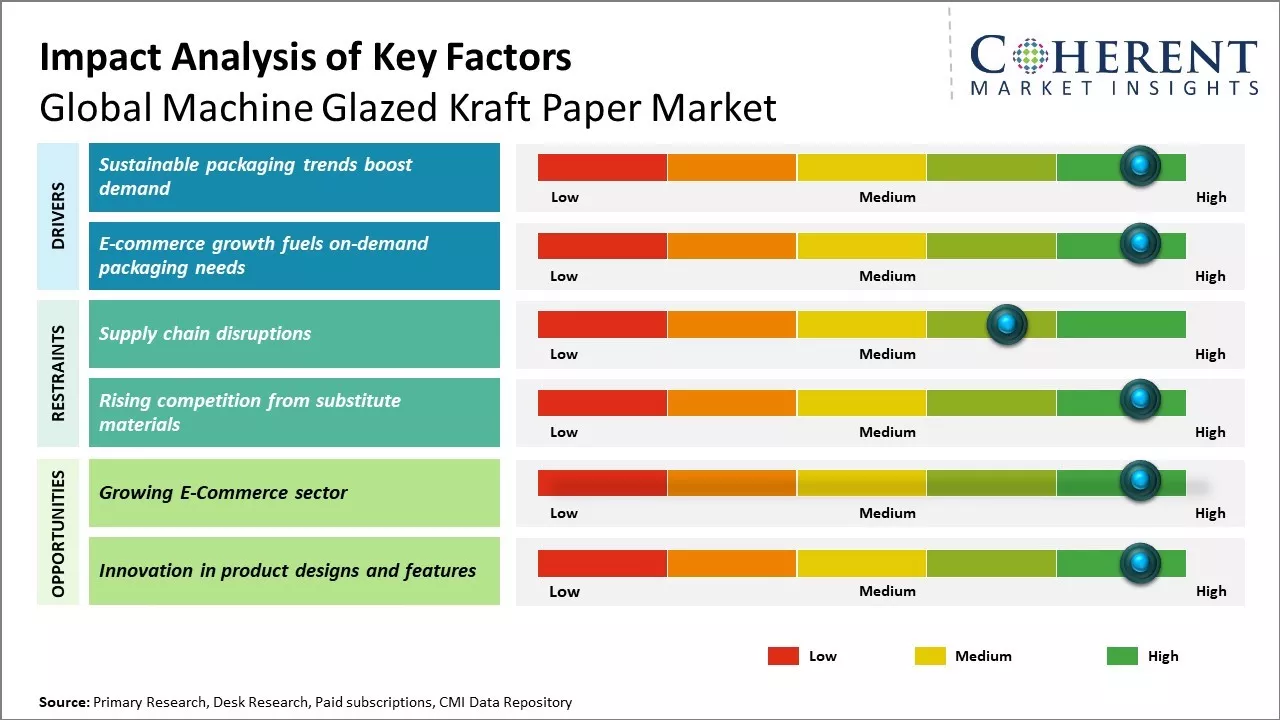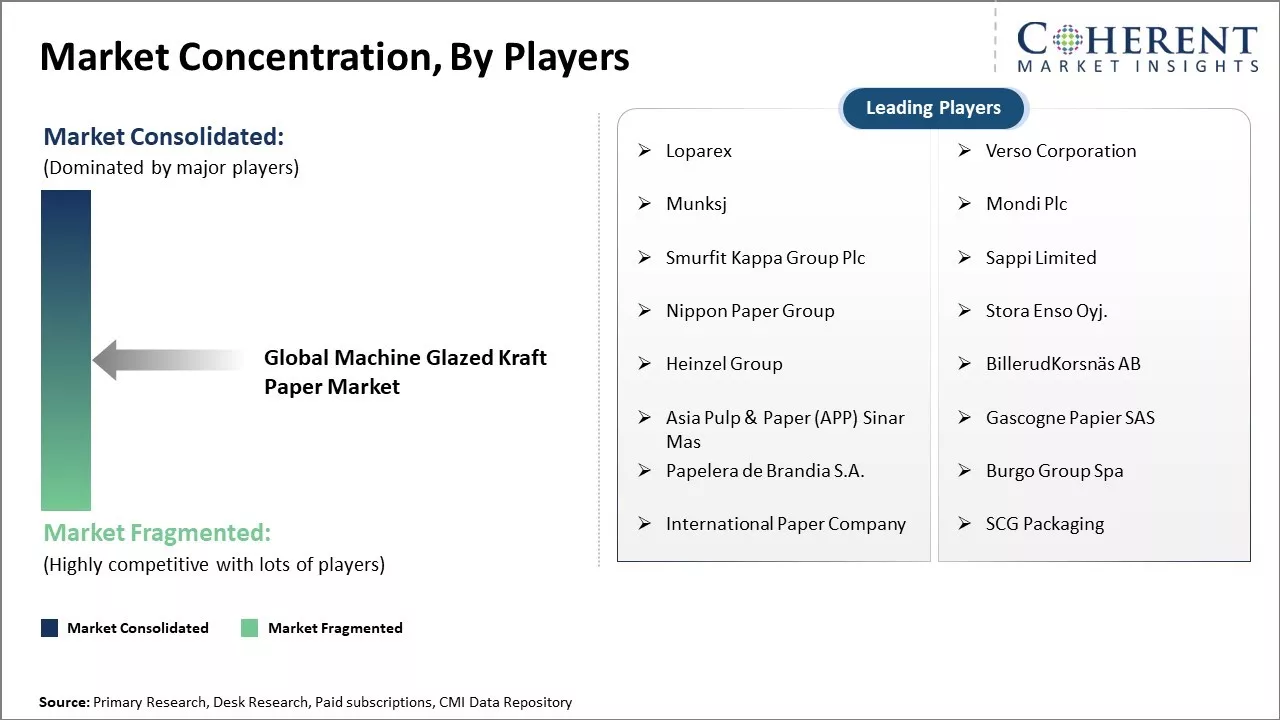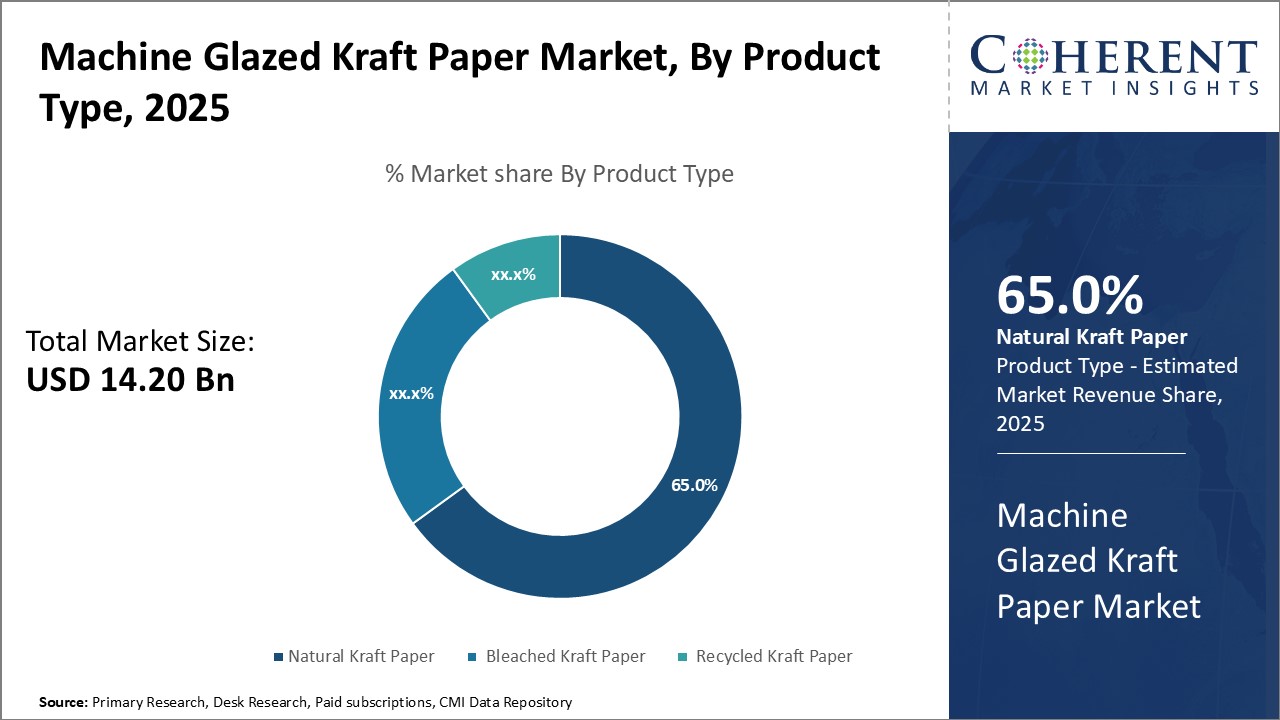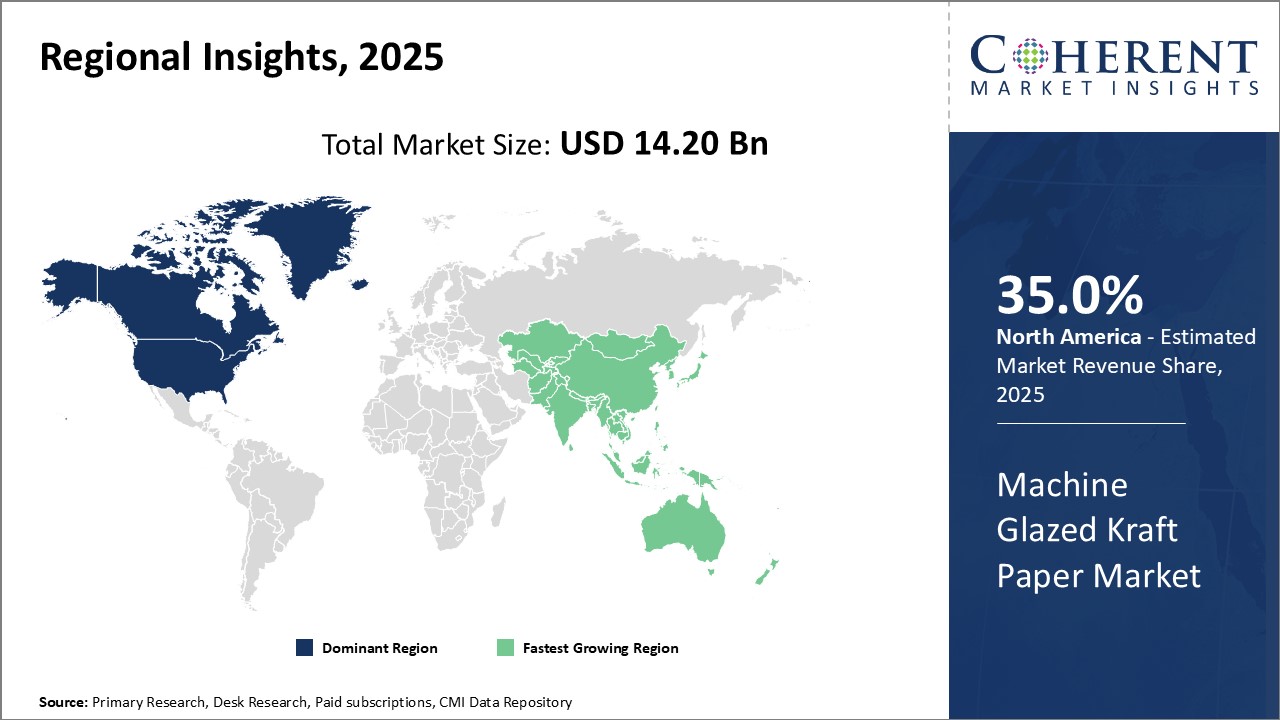The machine glazed kraft paper market is estimated to be valued at USD 14.20 Bn in 2025 and is expected to reach USD 19.87 Bn by 2032, exhibiting a compound annual growth rate (CAGR) of 4.9% from 2025 to 2032.

Discover market dynamics shaping the industry: Download Free Sample
The market has been witnessing steady growth over the past few years driven majorly by increasing demand from the food packaging and industrial sectors. The demand for machine glazed kraft paper is expected to continue growing during the forecast period supported by rising packaging consumption across various industries. Factors such as increasing focus on sustainability and preference for eco-friendly products are favoring the growth of the machine glazed kraft paper market. However, stringent government regulations pertaining to the use of plastics may restrain the market expansion to some extent.
Drivers of the Market:
Sustainable packaging trends boost demand
The growing inclination towards sustainable packaging solutions across various end-use industries has positively impacted the machine glazed kraft paper market. Manufacturers are under constant pressure to reduce the environmental footprint of their packaging and shift towards eco-friendly alternatives. Machine glazed kraft paper is completely recyclable and compostable, allowing products packed in it to have minimal negative impact on the surroundings at the end of the product life cycle.
Various regulatory mandates targeting waste reduction have further accelerated the sustainability drive. Packaging producers have proactively started incorporating more post-consumer recycled content and reducing excess material use. Machine glazed kraft paper perfectly aligns with these goals due to its light weight and minimum material requirements. It also allows creative designs and prints without the need for additional plastic films or polishing chemicals. Food brands in particular have warmed up to machine glazed kraft paper for its moisture resistance and microwave compatibility.

Get actionable strategies to beat competition: Download Free Sample
E-commerce growth fuels on-demand packaging needs
The increasing growth of the e-commerce industry has created consistent demand for effective packaging solutions. Online retailers are seeking robust yet affordable options to protect products during transit and present an appealing unboxing experience. Machine glazed kraft paper bags, pouches, and boxes have emerged as a popular choice due to their dual characteristics of sustainability and functionality.
Customers want their purchases to reach in perfect condition regardless of external conditions like rain, heat, or vibration during shipping. Machine glazed kraft paper adequately barricades products without adding unnecessary bulk. Its smooth and glossy appearance also provides brands opportunities for creative product marketing and differentiation through prints and designs. Growing cross-border trade has further fueled the requirement for packaging that can withstand international transportation networks.
Key Takeaways from Analyst:
The machine glazed kraft paper market continues to grow steadily supported by its wide range of end-use applications across industries. Key drivers for the market include growing demand from the packaging industry for applications such as wrappers, bags, and pouches. Increased consumption of ready-to-eat and packaged food & beverages has significantly contributed to the market growth. Strict global regulations regarding the use of single-use plastic are also favoring market expansion.
North America dominates the global market and is expected to witness the fastest growth over the forecast period. The expanding e-commerce industry and rising income levels are driving packaging consumption in the region's major economies including China and India. Rising industrial activities in Southeast Asian countries offer new opportunities. Meanwhile, North America and Western Europe remain other prominent markets driven by the established food processing and cosmetic industries.
Availability of alternative packaging materials, such as plastic, and availability of low-cost substitutes in developing countries could hamper the market growth. Moreover, fluctuations in paper pulp prices remain a longstanding challenge for manufacturers. Significant R&D investments are required for innovations and the development of high-performance grades.
Market Challenges: Supply chain disruptions
The machine glazed kraft paper market has been facing severe supply chain disruptions due to the COVID-19 pandemic and geopolitical issues. Lockdowns and mobility restrictions imposed by various governments disrupted manufacturing operations and transport networks globally. This led to shortages of raw materials for paper production. Additionally, the ongoing war between Russia and Ukraine has badly impacted the supply of pulp and other inputs which are largely sourced from these regions. Finding alternative suppliers at short notice has been quite challenging. Rising fuel and freight costs have also put pressure on manufacturers' margins. Meeting international quality standards and ensuring just-in-time deliveries to customers has become difficult. Many smaller players struggled to cope with these issues. Unless supply chains stabilize in the near future, it could negatively impact the growth prospects of this market.
Market Opportunities: Growing E-Commerce sector
The rapid growth of the e-commerce industry worldwide presents a massive opportunity for the machine glazed kraft paper market. Online shopping has seen a huge surge since the onset of the pandemic. More consumers are now preferring the contactless delivery of goods purchased on digital platforms. This has boosted the demand for secure, robust, and commercially-viable packaging solutions for shipping diverse products. Machine glazed kraft paper offers attributes like moisture resistance, strength, and printability which makes it ideal as the primary packaging material for e-commerce consignments. Manufacturers can gain by developing specialized grades, sizes, and designs optimized for the requirements of e-tailers and logistics companies. With digital commerce expected to steadily rise across regions, the market stands to benefit from strong volume growth in the coming years.

Discover high revenue pocket segments and roadmap to it: Download Free Sample
Insights by product type: Durability and sustainability drives the demand for natural kraft paper
In terms of product type, natural kraft paper is expected to contribute 65.0% share of the market in 2025, owing to its durable and sustainable properties. Natural kraft paper is made from pure wood pulp without any additives or chemicals, giving it a simple yet robust composition. This allows it to withstand heavy loads, moisture, and prevent tearing or puncturing during transportation and storage of goods. Its natural fibers also give it some flexibility without compromising on strength.
Due to its composition completely from wood fibers, natural kraft paper is 100% biodegradable and recyclable. This makes it an eco-friendly choice for packaging. More brands and retailers are focusing on using sustainable packaging options to achieve their own corporate social responsibility targets. Natural kraft paper helps them meet this goal. Its recyclability also appeals to environmentally conscious consumers who look for sustainable alternatives.
The raw materials for natural kraft paper come from responsibly managed forests. Many paper manufacturers have policies to source wood only from FSC or PEFC certified forests that follow sustainable practices. This credibility of using renewable resources from well-managed forestry drives the demand for natural kraft paper in applications where sustainability is an important criterion for selection. Demand also remains high from sectors like construction that require heavy-duty packaging for materials like tiles, bricks, steel, etc. Natural kraft paper excels at withstanding compression loads involved during shipping without breakage. Its moisture resistance keeps contents dry during transportation even in adverse conditions. These performance benefits of natural kraft paper have made it ubiquitous in the construction supplies chain.
Insights by application: Packaging drives the growth of market
In terms of application, packaging is expected to contribute 68% share to the machine glazed kraft paper market in 2025, due to the benefits of bleached kraft paper for the packaging industry. Bleached kraft paper undergoes additional processing compared to natural kraft which yields a brighter, neutral color paper with improved printability and aesthetic properties.
The post-bleaching process eliminates color pigments from the paper making it a blank canvas suitable for branding and labelling through printing. High resolution color printing can be used to make product packaging more visually appealing to attract customers on shelves. Many consumer goods brands leverage premium bleached kraft paper for primary and secondary packaging to build their brand image.
Bleached kraft paper is impermeable to moisture, oil, and grease, making it suitable for direct contact with food and consumer products. It does not leach any chemicals into the contents. The paper also has sufficient tensile strength for applications like cartons, boxes, and bags. These product-safe properties have popularized bleached kraft paper as a compliant substrate for food packaging across continents. Given the exponential rise in e-commerce, there is growing demand for robust corrugated packaging for shipping consumer and commercial goods. Bleached kraft paper is a prime raw material for corrugated board manufacturing. Its strength and printability give corrugated boxes made of bleached kraft an advantage over alternatives. This positions bleached kraft paper right at the center of the thriving packaging industry growth.
Insights by End-Use Industry: Regulations drive recycled kraft paper adoption in the food industry
In terms of end-use industry, food & beverages is expected to contribute 44.9% share of the machine glazed kraft paper market in 2025, due to factors driving recycled kraft paper usage. Recycled kraft paper is manufactured by pulping used paper and recycling fibers while adding minimal virgin fibers. Stringent regulations in the food industry now necessitate the use of paper packaging produced from recycled content. Food contact regulations in Europe and North America now require a specified minimum recycled fiber content to be climate-friendly and curb deforestation. This is a major shot in the arm for recycled kraft paper.
At the same time, major food brands are committed to sustainability and have set internal targets to switch to eco-friendlier packaging materials made from recycled fibers. Recycled kraft paper perfectly meets these objectives of the food titans. Its ability to be endlessly recycled into new paper products through modern recycling techniques has made it an attractive green option. The affordability of recycled paper relative to virgin kraft paper is an added advantage driving growth. Major food outlets are keen on optimizing packaging costs to improve margins without compromising on compliance. Recycled kraft paper achieves this in a sustainable manner through its reuse of existing fibers. This combination of regulatory tailwinds and sustainability requirements is cementing recycled kraft paper usage in the food vertical.

Need a Different Region or Segment? Download Free Sample
North America has dominated the global machine glazed kraft paper market for several years owing to strong demand from the food packaging and industrial packaging industries in the region. The region is expected to account for 35.0% of the market share in 2025. The U.S. is the single largest consumer of machine glazed kraft paper due to a well-established food processing industry and the presence of major paper product manufacturers. The availability of raw materials, such as wood pulp and recycling facilities, have allowed American producers to offer competitive prices. Major brands have captivated the retail segment through product differentiation and innovation in capabilities like moisture resistance.
The Asia Pacific region has emerged as the fastest growing market for machine glazed kraft paper in recent times, spurred by rapid industrialization and globalization of supply chains. China, in particular, has transformed into a manufacturing powerhouse catering to domestic as well as international demand. Chinese machine glazed kraft paper exporters have gained ground in Western markets through competitive pricing and a focus on quality certifications. Neighboring countries like India and Southeast Asian nations have also strengthened their industrial infrastructure and consumer markets. As a result, foreign and local paper producers are investing heavily in Asia Pacific to capitalize on the opportunities presented by its burgeoning middle class.
Machine Glazed Kraft Paper Market Report Coverage
| Report Coverage | Details | ||
|---|---|---|---|
| Base Year: | 2024 | Market Size in 2025: | USD 14.20 Bn |
| Historical Data for: | 2020 To 2024 | Forecast Period: | 2025 To 2032 |
| Forecast Period 2025 to 2032 CAGR: | 4.9% | 2032 Value Projection: | USD 19.87 Bn |
| Geographies covered: |
|
||
| Segments covered: |
|
||
| Companies covered: |
Loparex, Verso Corporation, Munksj, Mondi Plc, Smurfit Kappa Group Plc, Sappi Limited, Nippon Paper Group, Stora Enso Oyj., Heinzel Group, BillerudKorsnäs AB, Asia Pulp & Paper (APP) Sinar Mas, Gascogne Papier SAS, Papelera de Brandia S.A., Burgo Group Spa, International Paper Company, and SCG Packaging |
||
| Growth Drivers: |
|
||
| Restraints & Challenges: |
|
||
Uncover macros and micros vetted on 75+ parameters: Get instant access to report
*Definition: The machine glazed kraft paper market involves the production and sale of machine glazed kraft paper. This type of paper has a glossy, laminated surface created through a calendaring process using heated steel rollers. It provides excellent printing capabilities for flexible packaging applications like gift wrapping, bags, pouches, and labels. Machine glazed kraft paper is widely used in food packaging due to its high strength, moisture resistance, and ability to be written or printed on with minimal ink bleeding.
Share
Share
About Author
Yash Doshi is a Senior Management Consultant. He has 12+ years of experience in conducting research and handling consulting projects across verticals in APAC, EMEA, and the Americas.
He brings strong acumen in helping chemical companies navigate complex challenges and identify growth opportunities. He has deep expertise across the chemicals value chain, including commodity, specialty and fine chemicals, plastics and polymers, and petrochemicals. Yash is a sought-after speaker at industry conferences and contributes to various publications on topics related commodity, specialty and fine chemicals, plastics and polymers, and petrochemicals.
Missing comfort of reading report in your local language? Find your preferred language :
Transform your Strategy with Exclusive Trending Reports :
Frequently Asked Questions
Joining thousands of companies around the world committed to making the Excellent Business Solutions.
View All Our Clients